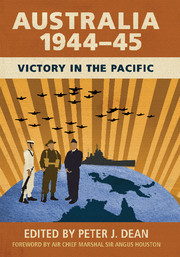Book contents
- Frontmatter
- Dedication
- Foreword
- Contents
- Maps and chart
- Figures and table
- Contributors
- Acknowledgements
- Abbreviations
- Military symbols on maps
- Introduction
- PART 1 STRATEGY
- PART 2 AUSTRALIA AT WAR
- PART 3 GREEN ARMOUR AND SPECIAL OPERATIONS
- PART 4 THE NAVAL AND AIR WAR
- PART 5 THE NEW GUINEA CAMPAIGN
- 10 ‘Given a second rate job’: Campaigns in Aitape-Wewak and New Britain, 1944–45
- 11 More Than Mopping Up: Bougainville
- PART 6 THE BORNEO CAMPAIGN
- Afterword: And Then Came Peace?
- Index
- References
10 - ‘Given a second rate job’: Campaigns in Aitape-Wewak and New Britain, 1944–45
from PART 5 - THE NEW GUINEA CAMPAIGN
Published online by Cambridge University Press: 05 December 2015
- Frontmatter
- Dedication
- Foreword
- Contents
- Maps and chart
- Figures and table
- Contributors
- Acknowledgements
- Abbreviations
- Military symbols on maps
- Introduction
- PART 1 STRATEGY
- PART 2 AUSTRALIA AT WAR
- PART 3 GREEN ARMOUR AND SPECIAL OPERATIONS
- PART 4 THE NAVAL AND AIR WAR
- PART 5 THE NEW GUINEA CAMPAIGN
- 10 ‘Given a second rate job’: Campaigns in Aitape-Wewak and New Britain, 1944–45
- 11 More Than Mopping Up: Bougainville
- PART 6 THE BORNEO CAMPAIGN
- Afterword: And Then Came Peace?
- Index
- References
Summary
Like the other Australian operations in the south Pacific in 1944–45, the campaigns in Aitape-Wewak and New Britain during those years have been tarred with the label of ‘unnecessary’. Certainly, there were soldiers fighting in these campaigns who were frustrated by their circumstances. Some Australian 6th Division veterans felt that they were ‘first rate troops given a second rate job’. Conversely many historians have argued that it is inaccurate and misleading to regard these campaigns as unnecessary (see chapter 1), but leaving aside the debates surrounding ‘mopping up’ at Aitape-Wewak, this campaign was one of the longest fought by Australian troops during the war, in some of the toughest and most unpleasant conditions.
THE AMERICANS AT AITAPE
The northern coast of New Guinea between Aitape and Wewak is characterised by low-lying swamps, thick vegetation and numerous streams prone to flooding. The coastal plain is hemmed in by the Torricelli Mountains, whose grassy foothills steadily rise, forming steep gullies and ridges above the coastal plain. On 22 April 1944, the US 163rd Regimental Combat Team of the 41st Division landed at Aitape. Their job was to capture and defend the nearby Tadji Airfield and to help block the Japanese Eighteenth Army, based around Wewak, from interfering with operations further westward at Hollandia. The Eighteenth Army, commanded by Lieutenant General Hatazō Adachi, had been in a continuous westward retreat along the coast since the Allied advances along the Huon Peninsula and Finisterre Range the previous year. On 3 May, the 163rd Regimental Combat Team was replaced by the US 32nd Infantry Division and the 112th Cavalry Regiment, and they were later joined by the 124th Regimental Combat Team of the 31st Infantry Division, as well as the 43rd Infantry Division. The task of the Americans was to protect the airfield, and they stayed mostly within their small perimeter. Between 10 July and 25 August, a major battle took place at the Driniumor River, 32 kilometres east of Aitape. On the night of 10–11 July, some 10,000 Japanese attacked the US positions across the Driniumor River. The attackers suffered appalling losses from machine-gun and artillery fire, and over the following weeks fell back to the Wewak area. During the initial attack, one Japanese battalion was hit by an artillery barrage and was reduced from 400 men to 30 within minutes.
- Type
- Chapter
- Information
- Australia 1944–45Victory in the Pacific, pp. 213 - 231Publisher: Cambridge University PressPrint publication year: 2015



